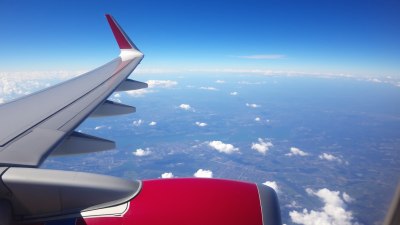When the Flight Feels Like Freedom
Exploring the liberating feelings associated with flying and travel in the modern world.

Throughout history, the concept of flight has been synonymous with freedom. As humans, we have always been driven by a profound desire to soar above the constraints of our earthly existence. The moment we step onto an airplane, we are not merely embarking on a journey from one destination to another; we are participating in an age-old dream that challenges the boundaries of gravity, geography, and our very existence.
As we settle into our seats, the whir of the engines is not just background noise; it's the sound of potential and adventure. There is a distinct beauty in watching the world shrink beneath us as we ascend through the clouds. The panoramic view of sprawling cities, lush landscapes, and winding rivers from the altitude of a commercial flight is a revelation. It serves as a reminder of how small we are in the grand scheme of the universe. This extensive vista can evoke feelings of both insignificance and liberation.
Physical Liberation in the Sky
Flight offers a peculiar kind of physical liberation. Trapped in routines, daily responsibilities, and societal structures, we often forget what it feels like to experience true freedom. The enchantment of being airborne grants us a temporary escape from these mundane aspects of life. The sensation of weightlessness that accompanies takeoff can be likened to shedding the burdens and constraints that tether us to the ground. As the aircraft climbs higher, so too do our spirits rise, elevated beyond our day-to-day worries.
In the modern age, air travel has become more accessible than ever. The ability to traverse continents in mere hours transforms the way we experience freedom. Gone are the days when traversing great distances required months of travel through uncharted territories. Today, with a few clicks on a screen, we can book flights to any corner of the globe, embarking on culinary and cultural adventures that stretch far beyond our hometowns.
The Emotional Aspects of Flight
Traveling by air isn't just a physical journey; it’s an emotional one. The excitement and anticipation that swell within us at the prospect of new experiences are palpable. The moment an airplane takes off, it ignites a rush of adrenaline that some may describe as exhilarating. We embrace the novelty, the unfamiliar sights, and sounds that await us at our destination. Whether flying to visit family, friends, or simply to discover new horizons, each flight symbolizes beginnings and reunions, new adventures and cherished memories.
Additionally, air travel can often evoke nostalgia. For some, airports are a physical representation of memories—those magical moments of saying goodbye or reuniting with loved ones can stir deep emotions. The endless stream of people, each with their stories and destinations, adds to the profound sensation of shared humanity. Each traveler carries a tapestry of experiences, dreams, and aspirations encapsulated momentarily within the walls of the airport.
The Sense of Adventure
There is an undeniable thrill in exploring new cultures and landscapes. With flight, possibilities become infinite. We can wake up in one city, immerse ourselves in its charm, culture, and delights, and by nightfall, find ourselves half a world away, absorbing entirely different customs and lifestyles. This sense of adventure—where one moment, we might be tasting street food in Bangkok and the next, embracing the art scene in Paris—underscores the freedom that flight brings into our lives.
Adventure isn’t just in the destinations themselves, but also found in the journey. The entire experience of navigating airports, boarding planes, and meeting fellow travelers embodies a spirit of exploration. Each flight feels like an invitation to expand our horizons, to strip away the labels we wear in everyday life and discover not just new places but new parts of ourselves.
Coping with the Fear of Flying
However, not everyone shares the same appreciation for flight. For many, the act of flying is fraught with anxiety and fear. The claustrophobia of being confined in a small space coupled with the thought of soaring thousands of feet above the ground can be daunting. It’s essential to acknowledge these fears while recognizing that they can be overcome. Many people have successfully managed their flight anxiety through various techniques, such as cognitive behavioral therapy, mindfulness, and relaxation techniques.
Understanding the mechanics of flight can also help. Grasping that aircraft are engineered to a level of safety that far surpasses that of other modes of transportation can offer reassurance. Additionally, knowing that millions of passengers take to the skies every day without incident can help alleviate some of the trepidation surrounding air travel.
Connection Through Flight
Among the most profound experiences associated with flight is the connection it fosters among people. No matter where we are from, whether we find ourselves on a flight to a bustling metropolis or a quiet hideaway, we share a common thread: the joy of exploration. This shared experience brings together individuals from diverse backgrounds and cultures, each with unique stories and perspectives. Conversations can spark with seatmates, leading to new friendships that span continents. These transient connections often remind us that while we may look different or speak different languages, our desires, dreams, and experiences bind us together.
Flight also facilitates the preservation of cultural heritage. In a world that seems increasingly divided by borders, air travel serves as a bridge, allowing us to exchange ideas and traditions, thereby enriching our understanding of one another. Events such as business meetings, cultural exchanges, and educational programs often occur between countries separated by vast oceans, thanks in part to the convenience of air travel.
Environmental Considerations
Despite the joys of flight, we must also confront the environmental impact that aviation has on our planet. The carbon emissions from flights contribute significantly to climate change. Conversations surrounding sustainable aviation practices are increasingly urgent, as the industry grapples with the challenge of reducing its carbon footprint while meeting the sky-high demand for travel.
Efforts to develop more efficient engines, alternative fuels, and better operational practices are underway. Innovations such as electric airplanes are on the horizon, hoping to mitigate some of these environmental concerns. Meanwhile, travelers can also play a role by considering their travel habits. Opting for direct flights, supporting airlines that prioritize sustainability, and participating in carbon offset programs can all contribute to a more balanced approach to flying.
The Future of Flight
As we look towards the future of flight, advancements in technology promise to transform our experience even further. Concepts of supersonic travel, urban air mobility, and even space tourism captivate our imagination and hint at a world where flight feels even more like freedom. Emerging technologies may make it possible for us to traverse great distances in mere hours while doing so more sustainably and safely. The prospect of floating above the world, witnessing our planet from a vantage point once reserved for a select few, encapsulates the essence of freedom.
Ultimately, the act of flying symbolizes our relentless pursuit of freedom, exploration, and connection. Flight is not merely a mode of transportation; it is a gateway to experience life beyond our own limitations. Each time we take to the skies, we reaffirm that sense of liberation, a reminder that the journey—filled with adventures, stories, and human connections—is just as important as the destination. With the world at our fingertips, we can embrace the freedom that comes with flight, expanding our horizons and igniting our souls with the spirit of adventure.











